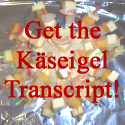Raclette, Fondue & Bleigießen
In this edition of German Words Explained we take a look at three traditions associated with New Year’s Eve.
Raclette is originally a traditional Swiss dish made from cheese. A large piece of cheese is put near a fire and is brought to melting point. When the cheese is soft and about to melt, a layer is scraped of and eaten with bread.
The modern raclette is an electrical table-top heater. Small dishes are filled with chopped-up vegetables, eggs, sausage rings and other small pieces of food and then covered with cheese. These are then placed under the element of the raclette. Many raclettes have a metal top where meat or bread can be fried, some even have stone tops for cooking steak.
Foundue is probably the most well-known outside of Germany, also being a traditional Swiss dish. Originally made by melting cheese and often wine over a flame, many people in Germany use the same form to heat cooking oil on New Year’s Eve and cook small pieces of meat in it. Others melt chocolate instead and dip pieces of fruit in it.
Bleigießen is definitely not to eat, it is a tradition that families carry out on New Year’s Eve. They buy small packets of lead – often together with a special spoon. The lead cubes are placed on the spoon and held over a candle so that they melt. Once the lead is molten, it is dropped into cold water where it sets into a new form. The trick is then to decipher what the form means for each person for the coming year.
To hear a simple explanation and a short discussion in German, listen to the podcast:
(Press the “play” button to listen to the podcast)
Download the MP3 file | Subscribe to the podcast
Tags: Bleigießen, Fondue, Lead, New Year's Eve, Raclette, Silvester





December 30th, 2009 at 7:00 pm
[…] lead or even silver were added. Often this meant that it was used on New Year’s Eve for Bleigießen. However, modern Lametta is often made of […]
December 30th, 2009 at 7:03 pm
[…] lead or even silver were added. Often this meant that it was used on New Year’s Eve for Bleigießen. However, modern Lametta is often made of […]
December 30th, 2009 at 7:10 pm
[…] lead or even silver were added. Often this meant that it was used on New Year’s Eve for Bleigießen. However, modern Lametta is often made of […]
January 23rd, 2010 at 10:09 am
Thank you for discuss this. Hot blog post on your website. I was reading your posting and I have bookmark your blog already.